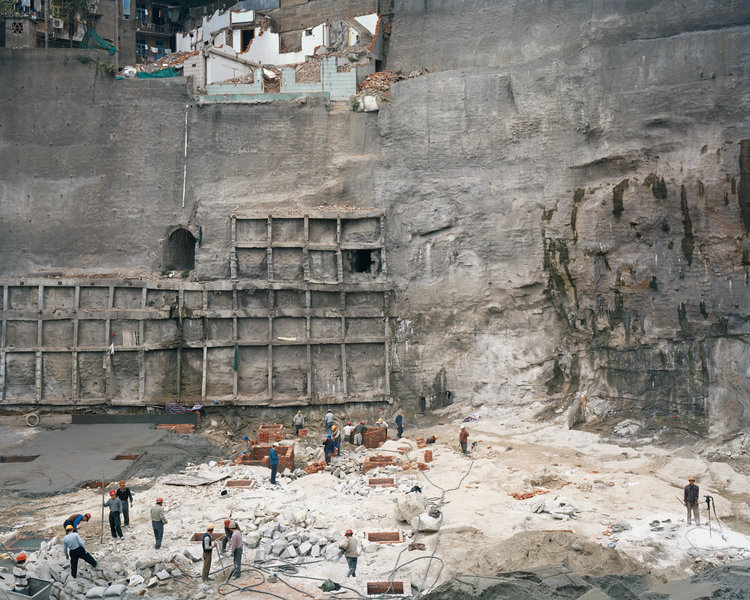WITH BAS PRINCEN: INSTRUMENTS
BY SUSANA VENTURA
SV: How many times do you go to a certain place before shooting it? How do you prepare yourself to enter the place through the picture you are about to shoot?
BAS: I visit a place once. Many people think that you need to scout a place and then return when the light is better... I understand photography in a way that allows me to go further. Things are always evolving. If you go to a place twice, it’s going to be different, and most probably I will be interested in something I did not even see the first time around.
SV: Which instruments do you use for shooting?
BAS: I go with my camera and tripod, but what is more important, is the walking with the camera, the slow movement to find an image is more valuable than the camera itself. This idea of a reference image is also an extremely important instrument in conceiving the image, besides the kind of banal technicality of the camera, the fact that you go with a certain image already in your mind, a kind of a set of possible com- positions and objects and relations, are the most important elements for shooting.
SV: Do you use a digital or an analogue camera?
BAS: At this point, I use a digital Back on a TC, but most the photographs that you know are still made with a Analogue 4 x 5 inch TC. This move to digital, I must admit, changes the way of photographing. So, I am still not used to the digital camera, because I really stopped using the analogue at all, because I thought if I would mix them up, it always would be a fight between one and the other, and it is better to make a clean cut. The two give very different results, with their own character, so the move to digital allows me also to see things new again, and that is what I like a lot, but I miss the big upside down matheglass... The fact that you can see immediately what you’ve made is not always an advantage. Or not an advantage yet, maybe it’s the right way to say it (sic).
SV: You say that after shooting takes place an elimination process. Of course, there is an elimination process that occurs during the shooting when you’re looking for the frame and the distance and the colour, but are there any more elimination processes?
BAS: Of course, there are many elimination processes.
SV: Can you describe them in general terms? What are those processes?
BAS: The first, of course, it’s the shooting, where you go, if you’re there and decide to take the picture or not – this is already quite important – then when you review for the first time the image – on the computer or in the print – that’s the moment where you realise if the picture works outside of its context and, of course, this is what you want. You want the picture to work independently. But somehow at least half of the pictures that I make, that I initially make, when the context is not there, they don’t work anymore which is funny, I even try hard to avoid this context, but sometimes without it, it does not work well. So, in the elimination process, I really look for the images that can stand by themselves or are able to depict a landscape in all its ambiguity without refer- ring to its original. Then, after that, the next process is to see if the image works within the series that you’re making, if they add something, if they compliment 2 previous works for instance, that is ideal. If not, it means that the type of place is good and the idea is good, but the image is not yet there, and then I consider that photograph as a test for an image that still has to be made. So, a lot of times, the elimination process means that there is something in the image that has to be found again, because it doesn’t fit yet completely. In the end, there are not a lot of photographs. But I wouldn’t call it a processes of elimination, and rather prefer to call them processes of combin- ing things that make sense. It’s really about finding connections between previously made images and the new ones. If they are completely on their own, without referring to other photographs, there’s no reason to use them.
SV: Finally, what makes you reject a photograph?
BAS: I really have to print them out to decide if they’re good or not. I can’t do it on the screen. And I ask other people to see if the photograph can stands on itself, and how they perceive the image, what it tells them. I don’t trust me, because I know too much about the actual place, if any of these parameters are not met, then I slowly work onward on the same idea, but I just don’t use that particular images.
SV: But do you do photoshop or not?
BAS: Of course, there’s no way around it. If you start to work with these new digital cameras, the image that comes out is so rough that it’s not a useful image. So, you have to use it. You cannot just print that file, otherwise it will look like soft and without depth. In the end, it’s like a negative, it still has to go through a process of making. It’s the same: you cannot show a negative neither. So, you need to use photoshop or any other program in order to have at least one round of determining how the image should be. And then you have to print it and when it’s printed somehow you’re able to see if the image can stand on its own and can become a work on itself.


